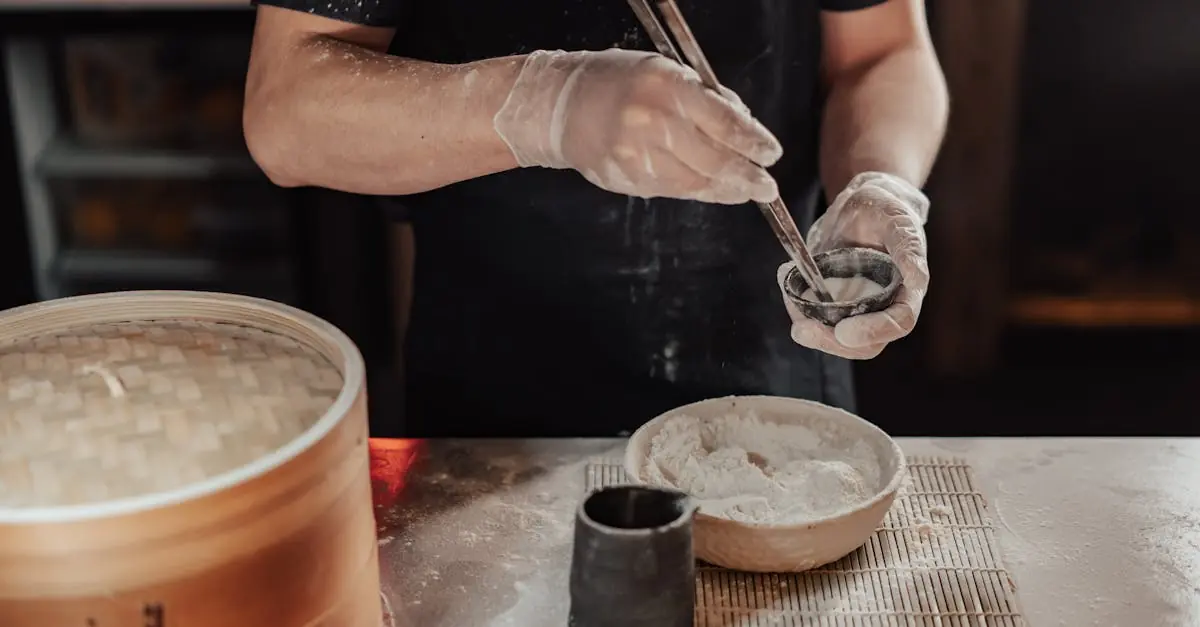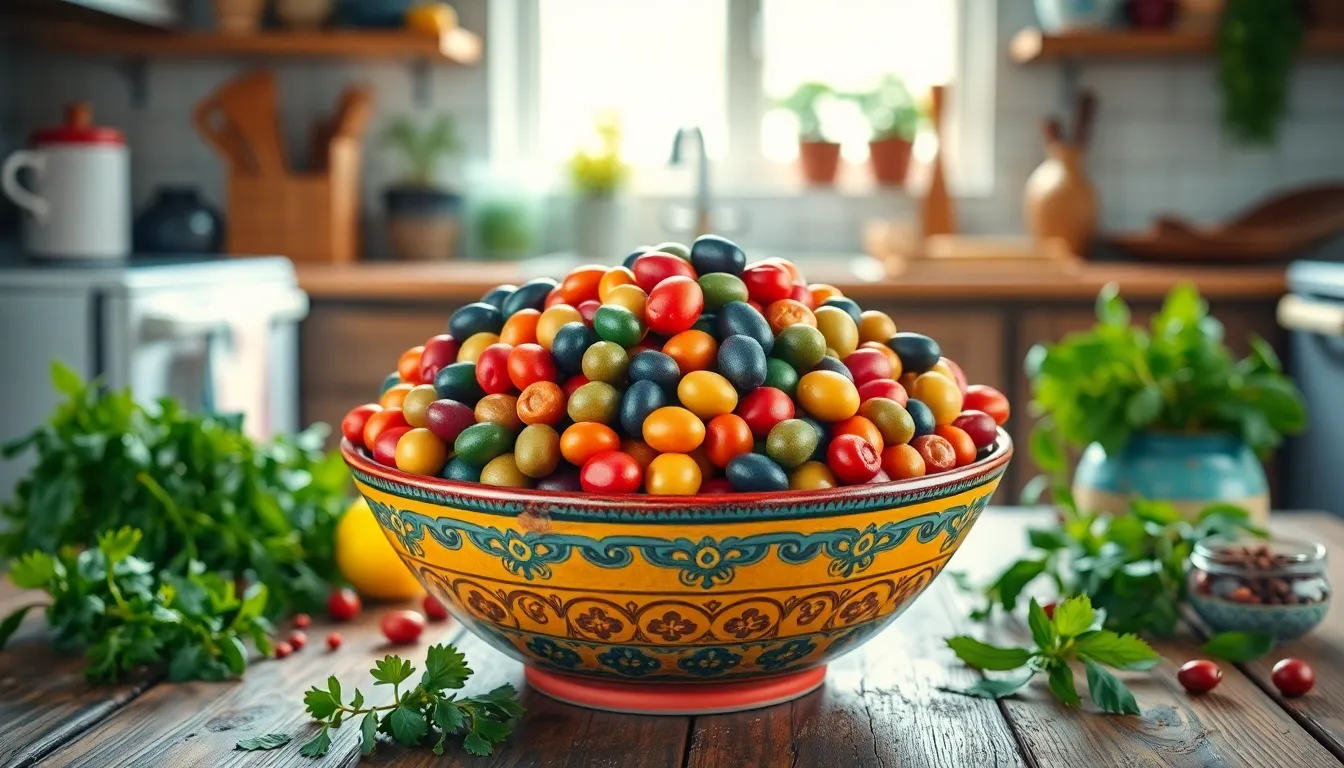Japanese cooking techniques are like a well-kept secret whispered among culinary ninjas. They blend precision, artistry, and a sprinkle of magic that transforms simple ingredients into extraordinary dishes. From the delicate dance of sushi-making to the sizzling spectacle of teppanyaki, these methods aren’t just about food; they’re about creating experiences that tantalize the taste buds and warm the soul.
Table of Contents
ToggleOverview Of Japanese Cooking Techniques
Japanese cooking techniques highlight the balance of flavor, texture, and presentation. Precision defines many methods, enabling chefs to transform fresh ingredients into beautiful dishes. Ingredient preparation, cooking methods, and artistic plating showcase the culinary culture.
Sushi preparation represents an intricate skill. Chefs focus on the quality of rice and fish, emphasizing freshness and taste. Techniques like molding rice and selecting toppings demonstrate attention to detail.
Grilling methods like yakitori involve skewering marinated chicken or vegetables and cooking them over charcoal. Smoke enhances the flavor while achieving a desirable char. This technique maintains integrity while enriching taste.
Simmering, or nimono, plays a significant role in Japanese cooking. Ingredients cook slowly in a seasoned broth, allowing flavors to meld harmoniously. This method applies to vegetables, fish, or meats, showcasing simplicity and depth.
Steaming is another vital technique. It preserves nutrients while keeping textures intact. Dishes like chawanmushi, a savory egg custard, exemplify this process as flavors develop naturally.
Frying, particularly tempura, involves coating seafood or vegetables in a light batter before deep-frying. The result yields a crispy exterior while maintaining moisture. This contrast creates a delightful eating experience.
Finally, presentation remains a key aspect. Plate arrangement involves color, texture, and symmetry to engage the diner visually. Each dish represents not just a meal but an artistic expression reflecting the seasons and ingredients.
Essential Cooking Tools
Japanese cooking relies on specific tools that enhance techniques and elevate dishes. Understanding these essential tools aids in mastering culinary skills.
Knives
Knives play a critical role in Japanese cuisine. A yanagiba excels at slicing sushi and sashimi with precision. Santoku knives offer versatility for various ingredients, including vegetables and meats. Gyoto knives serve as chef’s knives for general purposes, making them essential in any kitchen. Proper maintenance enhances the lifespan and performance of these knives. Whetstones are crucial for sharpening, ensuring blades remain razor-sharp for delicate cutting tasks.
Cookware
Cookware forms the backbone of Japanese culinary techniques. Heavy iron skillets are perfect for creating crispy tempura, while donabe, or clay pots, provide superior heat retention for steaming and simmering dishes. A tamagoyaki pan helps craft the iconic Japanese omelet by allowing even cooking. Takoyaki grills, designed specifically for making octopus balls, showcase the importance of specialized cookware in achieving authentic results. Stainless steel or wooden bowls support ingredient preparation, ensuring efficiency during food assembly.
Fundamental Techniques
Japanese cooking relies on diverse techniques that enhance flavors, textures, and presentation. Mastering these fundamentals elevates each dish.
Slicing and Dicing
Precision defines the art of slicing and dicing in Japanese cuisine. Chefs use specialized knives, such as the yanagiba and santoku, to achieve perfect cuts. Dicing ingredients like vegetables ensures even cooking and enhances presentation. Techniques vary depending on the dish; for example, sushi requires thin slices for fish while soups benefit from uniform vegetable cuts. Proper technique not only improves texture but also maximizes flavors by allowing ingredients to interact harmoniously. Acknowledging the importance of maintaining sharp knives further contributes to the quality of each slice.
Braising and Steaming
Braising and steaming techniques exemplify the gentle methods of Japanese cooking. Simmering dishes, known as nimono, allows flavors to meld deeply over time. This technique often incorporates a dashi or soy sauce base, enriching the dish with umami. Steam cooking preserves nutrients, texture, and natural flavors, as seen in chawanmushi. Bamboo steamers and donabe are common tools used for optimal results. While both methods focus on enhancing ingredient qualities, careful attention to timing ensures dishes remain tender and flavorful. Understanding these techniques contributes to the authenticity of Japanese cuisine.
Unique Styles
Japanese cooking incorporates various unique styles, each showcasing skill and tradition through specific techniques.
Sushi Preparation
Sushi preparation emphasizes precision and quality. Expert chefs focus heavily on rice and fish selection, ensuring the freshest ingredients. The rice, seasoned with vinegar, salt, and sugar, becomes a fundamental element. Techniques like hand-rolling and knife skills are vital in shaping each piece. The use of the yanagiba knife ensures clean cuts, enhancing the presentation. Chefs train for years to master these techniques, elevating sushi from simple food to an art form.
Ramen Making
Ramen making involves multiple components that contribute to an exceptional bowl. Broth serves as the heart of the dish, with variations like tonkotsu or shoyu providing different flavors. Noodle texture, typically thin and chewy, plays a crucial role in the overall experience. Toppings, such as chashu pork, soft-boiled eggs, and green onions, add layers of flavor. Each step demands attention to detail, from simmering the broth for hours to achieving the perfect noodle consistency. Chefs constantly refine their methods to create a signature ramen that delights the palate.
Presentation and Aesthetics
Presentation in Japanese cooking exemplifies artistry and attention to detail. Chefs prioritize color, texture, and symmetry when arranging dishes, creating a visual feast that enhances the dining experience. Seasonal elements often inspire these arrangements, showcasing fresh ingredients and reflecting nature’s beauty.
Each dish serves as a canvas, with careful placement elevating simple ingredients into remarkable works of art. For instance, sushi displays layers of fish and rice, highlighting their freshness and quality. In contrast, a bowl of ramen combines vibrant toppings, enticing the eye before flavor touches the palate.
Textures carry significance, too. A balance of crispy, tender, and creamy elements creates an engaging sensory experience. Tempura offers a striking contrast between a crispy exterior and moist interior, while chawanmushi, a savory steamed egg custard, presents smoothness inviting exploration.
Plates frequently serve as the presentation medium, crafted from traditional materials such as ceramic or lacquerware. These selections enhance the dish’s overall appeal. The arrangement of food often mirrors cultural traditions, engaging diners visually and emotionally.
Furthermore, garnishes play an essential role in presentation. Edible flowers or delicate herbs add an extra layer of sophistication, lifting the dish’s aesthetic appeal. This attention to detail drives the notion of “ichiju-sansai,” which emphasizes a harmonious balance of one soup and three side dishes in Japanese meals, enhancing both flavor and visual beauty.
Incorporating these elements transforms each meal into a celebration, captivating diners with not only taste but also sight. Such dedication to aesthetics turns dinner into an experience, leaving a memorable impression long after the final bite.
Japanese cooking techniques embody a rich tapestry of tradition and innovation. Each method reflects a deep respect for ingredients and a commitment to craftsmanship. From the precision of sushi-making to the artistry of presentation, these techniques transform meals into unforgettable experiences.
The balance of flavor and texture is paramount in Japanese cuisine, showcasing the skillful use of tools and cooking methods. As chefs continue to refine their craft, they honor the principles that have defined Japanese cooking for centuries. Embracing these techniques not only enhances culinary skills but also fosters a greater appreciation for the artistry behind each dish. Ultimately, exploring Japanese cooking offers a journey into a world where food becomes an expression of culture and creativity.




